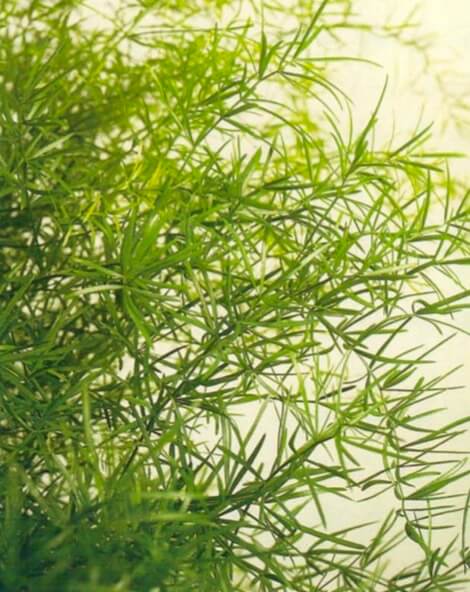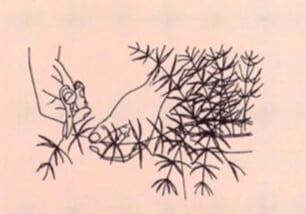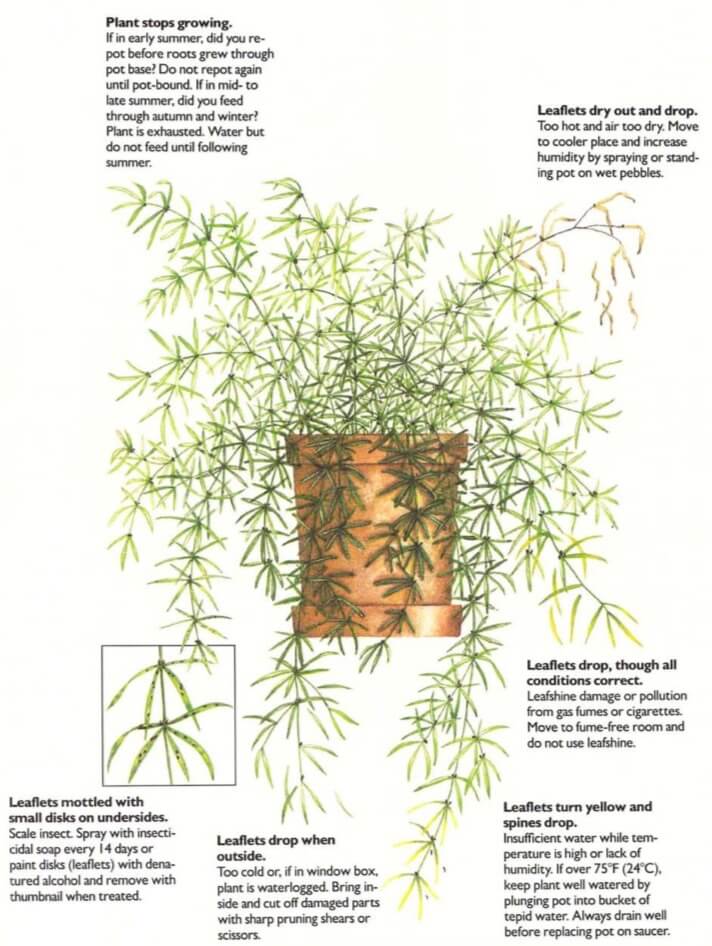[Ebook Việt Hoá] The Instant Guide to Healthy Houseplants (Hướng dẫn tức thời để chăm cây trong nhà khoẻ mạnh), Chi Asparagus - Chi Măng Tây
[Ebook Việt Hoá] The Instant Guide to Healthy Houseplants: Asparagus densiflorous ‘Sprengeri’ (Sprenger asparagus)
- Nguồn: [Ebook Việt Hoá] The Instant Guide to Healthy Houseplants (Hướng dẫn tức thời để chăm cây trong nhà khoẻ mạnh)
- Biên tập: Dũng Cá Xinh
- Biên dịch: Team Codai.net
English
This plant is often called an asparagus fern but actually looks quite different. It becomes bushy, with fronds both rising and trailing, which makes it attractive as a hanging plant. It is the easiest of the Asparagus varieties to grow. The foliage keeps well when cut and can be used in floral decorations. The leaves are prickly and have sharp needles at the base. A. densiflorous ‘Sprengeri’ is a good plant for the kitchen or bathroom. When foliage becomes very overcrowded in the pot, the plant can be divided in the spring. The roots are tuberous, and you will need a sharp knife to separate them. Several cultivars are available as well, including ‘Sprengeri Deflexus’, ‘Sprengeri Nanus’ and ‘Sprengeri Robustus’.

Light
Prefers light location without direct sunlight. Will survive in shade.
Humidity
Spray with tepid water twice a week in summer and once a week in winter. Spray even if out-of-doors; if very hot, spray daily. To maintain humidity stand plant on a saucer of pebbles almost covered with water.
Soil
Peat-based soil blended with fertilizer is ideal. If using loam- based mixture, choose one with a low level of fertilizer and blend 50:50 with peat.
Repotting
In spring, transfer into clay pot one size larger only if plant is pot-bound. Ensure good drain- age in pot.
Cleaning
Spraying with water is sufficient. Use no leafshine. .
Cutting off dead fronds
If dead or damaged fronds are unsightly, cut them off with sharp pruning shears or florists’scissors. Cut stem cleanly just above a pair of leaves. Keep fronds healthy by spraying regularly with tepid water. If very hot and dry, stand pot on saucer of damp pebbles to increase humidity.

What Goes Wrong

- Plant stops growing: If in early summer, did you repot before roots grew through pot base? Do not repot again until pot-bound. If in mid- to late summer, did you feed through autumn and winter? Plant is exhausted. Water but do not feed until following summer.
- Leaflets dry out and drop: Too hot and air too dry. Move to cooler place and increase humidity by spraying or standing pot on wet pebbles.
- Leaflets drop, though all conditions correct: Leafshine damage or pollution from gas fumes or cigarettes. Move to fume-free room and do not use leafshine.
- Leaflets turn yellow and spines drop:Insufficient water while temperature is high or lack of humidity. If over 75°F (24°q , keep plant well watered by plunging pot into bucket of tepid water. Always drain well before replacing pot on saucer.
- Leaflets drop when outside: Too cold or, if in window box, plant is waterlogged. Bring inside and cut off damaged parts with sharp pruning shears or scissors.
- Leaflets mottled with small disks on underside: Scale insect. Spray with insecticidal soap every 14 days or paint disks (leaflets) with denatured alcohol and remove with thumbnail when treated.
Tiếng Việt
This plant is often called an asparagus fern but actually looks quite different. It becomes bushy, with fronds both rising and trailing, which makes it attractive as a hanging plant. It is the easiest of the Asparagus varieties to grow. The foliage keeps well when cut and can be used in floral decorations. The leaves are prickly and have sharp needles at the base. A. densiflorous ‘Sprengeri’ is a good plant for the kitchen or bathroom. When foliage becomes very overcrowded in the pot, the plant can be divided in the spring. The roots are tuberous, and you will need a sharp knife to separate them. Several cultivars are available as well, including ‘Sprengeri Deflexus’, ‘Sprengeri Nanus’ and ‘Sprengeri Robustus’.

Light
Prefers light location without direct sunlight. Will survive in shade.
Humidity
Spray with tepid water twice a week in summer and once a week in winter. Spray even if out-of-doors; if very hot, spray daily. To maintain humidity stand plant on a saucer of pebbles almost covered with water.
Soil
Peat-based soil blended with fertilizer is ideal. If using loam- based mixture, choose one with a low level of fertilizer and blend 50:50 with peat.
Repotting
In spring, transfer into clay pot one size larger only if plant is pot-bound. Ensure good drain- age in pot.
Cleaning
Spraying with water is sufficient. Use no leafshine. .
Cutting off dead fronds
If dead or damaged fronds are unsightly, cut them off with sharp pruning shears or florists’scissors. Cut stem cleanly just above a pair of leaves. Keep fronds healthy by spraying regularly with tepid water. If very hot and dry, stand pot on saucer of damp pebbles to increase humidity.

What Goes Wrong

- Plant stops growing: If in early summer, did you repot before roots grew through pot base? Do not repot again until pot-bound. If in mid- to late summer, did you feed through autumn and winter? Plant is exhausted. Water but do not feed until following summer.
- Leaflets dry out and drop: Too hot and air too dry. Move to cooler place and increase humidity by spraying or standing pot on wet pebbles.
- Leaflets drop, though all conditions correct: Leafshine damage or pollution from gas fumes or cigarettes. Move to fume-free room and do not use leafshine.
- Leaflets turn yellow and spines drop:Insufficient water while temperature is high or lack of humidity. If over 75°F (24°q , keep plant well watered by plunging pot into bucket of tepid water. Always drain well before replacing pot on saucer.
- Leaflets drop when outside: Too cold or, if in window box, plant is waterlogged. Bring inside and cut off damaged parts with sharp pruning shears or scissors.
- Leaflets mottled with small disks on underside: Scale insect. Spray with insecticidal soap every 14 days or paint disks (leaflets) with denatured alcohol and remove with thumbnail when treated.
![[Ebook Việt Hoá] The Instant Guide to Healthy Houseplants: Asparagus densiflorous ‘Sprengeri’ (Sprenger asparagus) [Ebook Việt Hoá] The Instant Guide to Healthy Houseplants: Asparagus densiflorous ‘Sprengeri’ (Sprenger asparagus)](https://vn1.vdrive.vn/codai.net/2020/02/ebook-huong-dan-tuc-thoi-cham-cay-trong-nha-khoe-manh-100-asparagus-densiflorous-sprengeri.jpg)


